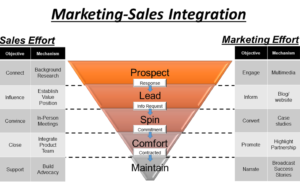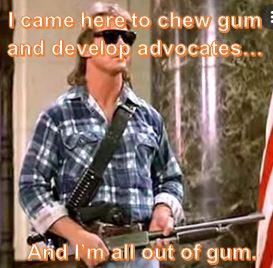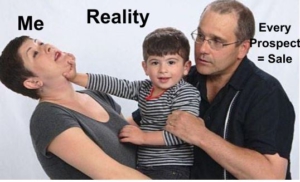A Sales and Marketing Love Story in Four Acts
ACT I
ACT I
In the ideal land of corporate operations, sales and marketing teams nest their efforts to accelerate the transition of a prospect into a brand advocate. However, reality often consists of rival sales and marketing teams squaring off like the Sharks and the Jets from West Side Story. We all know the age old story: sales believes that marketing is failing to generate leads while marketing believes that sales strikes out with the leads the marketing team hands them. We here at Auto Labs have developed a process that mashes sales and marketing together into an optimized and accelerated customer journey.

First, let us define the fundamental structure of our process. On the left and right sides, you see sales and marketing efforts that further break down to an “objective” and “mechanism” which correspond to each phase within the sales funnel. Both sales and marketing efforts converge into a focused approach that drives customers further down the funnel by applying the appropriate mechanisms to achieve their objectives during each phase. The silver boxes define the transition criterion to move the customer to the next phase and transition the respective sales and marketing approaches. Ideally, you have multiple customers in different phases that your sales and marketing teams are driving further down the process all the while collaborating and leveraging specific capabilities and talents at the right time. Bottom line: this approach fails if your sales and marketing are not working as a team.

The shape of the funnel indicates that while many prospects begin this process, few will emerge on the far side as advocates. Let us be honest: your team is not going to bat a 1000 unless you are selling syrup at the National Waffle Convention; hence, the inverted pyramid of reality and disappointment remains our morose choice of geometric representation.

We here at Auto Labs believe that this process applies to any customer journey regardless if you are selling oil changes or starting a karate dojo in Reseda. This is a descriptive process as opposed to a prescriptive method. One can scope, scale, and/or alter this construct as necessary. Our future discussions will both explain how this process works for us and offer suggestions as to how you can implement a similar model within your team. We know that we do not have all the answers when it comes to integrating sales and marketing into a combined effort, but our two teams work well together. To the best of their knowledge, nobody has let the air out of anyone’s tires in the parking lot, and we aim to keep it that way.

This is the first post in a series that will break down our process phase by phase. That is right, we are going on an adventure. In the end, we want to explain how to focus the talents of both your sales and marketing teams to facilitate the most efficient and optimized customer journey. Selling something is not difficult; the challenge lies with minimizing the time and resources required to make the sale all the while building advocacy within your customer base. So stay turned for next month’s article where we will meet our first group of prospects as they begin their journey.

Want to make Sophi CX a part of your Sales and Marketing Team?

 A Marketing and Sales Love Story: Act II
A Marketing and Sales Love Story: Act II